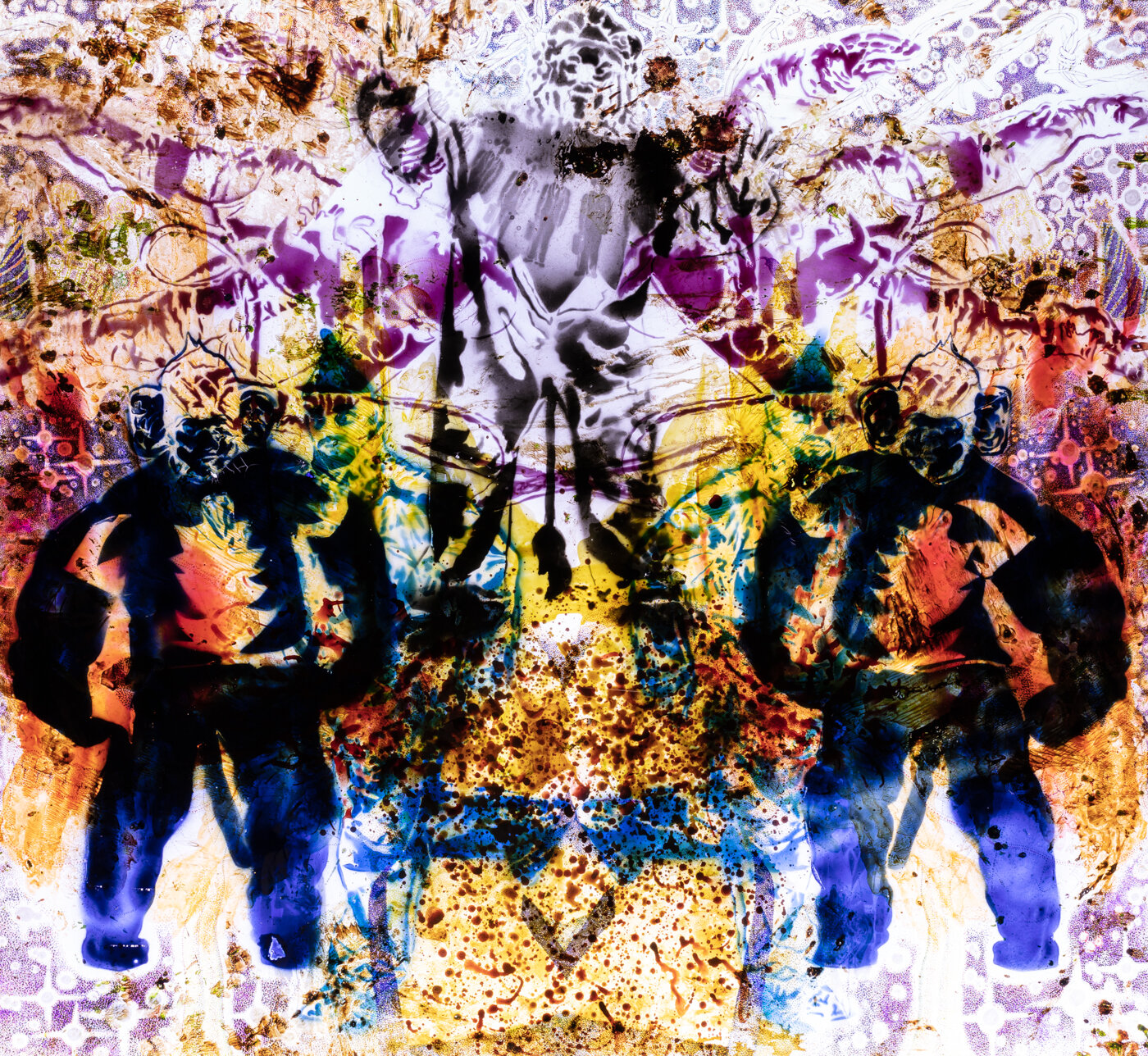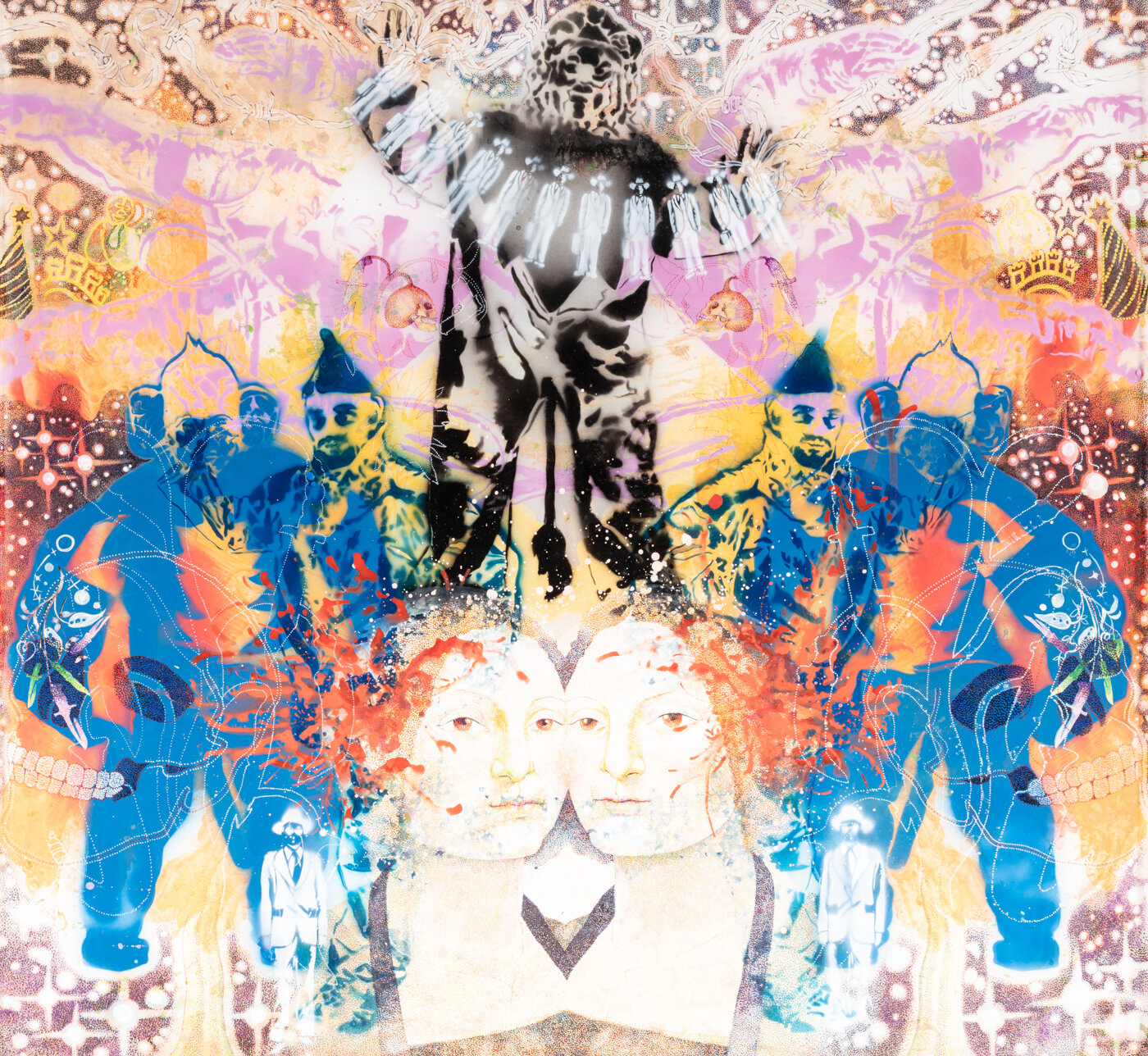Faiza Butt
In our next edition of #SAIatHome featuring artists from our latest exhibition Old Traditions, New Narratives: South Asian Miniatures, we talk to Neo-miniaturist Faiza Butt. One of several women artists featured in this exhibition, Butt uses her work to bring attention to issues related to identity, sexuality, politics and history.
Faiza Butt studied at National College of Arts in Lahore, Pakistan, prior to obtaining her MFA from Slade School of Art in London. She currently lives and works in London. Faiza sits down with SAI to tell us about her unique hybrid technique that combines the par dokht (pointillist) miniature technique and pixel structure of photographs. The current exhibition features her works created on polyester film.
“My fondest memory from NCA is the very realization that immense learning and vast knowledge can be communicated without having to memorize facts. The freedom of expression brought the best out of us.”
As a prominent South Asian feminist artist how does your work bring attention to issues related to the female identity and sexuality?
I believe my practice addresses the issue of human condition, in general. As a woman I do bring my unique experiences and observations to that field of knowledge.
Human condition is a vast umbrella of discussion and study that investigates individual fragility, gender politics, sexuality and many other cross cultural issues that remain part of that particular domain.
As an artist, I try to bring concepts that are steeped in ‘taboo’ into my practice. I do believe artists bear the moral responsibility to be social commentators. I have witnessed my share of political turmoil and upheaval growing up in the 80s during the General Zia era in Lahore. These were the founding years of my creative imagination. The repercussions of those changes became the foundation stone of my artistic sensibility. I believe my work still draws from memories of the popular culture of Lahore as I increasingly draw from memory to create work.
I do believe artists bear the moral responsibility to be social commentators.
Can you speak to the duality of how men and women are represented in the work ‘The End has no End’? Can you expand on your choice of the title for the work?
‘The End has no End’ is one of the seminal works of my career. It features some unique experimental techniques and mark making methods. I use stenciling and my unique pointillist technique to create a nebulous, mirror composition that is laced with meaning. The translucent surface of Mylar/ polyester film lends the work to be activated by light. The artwork is mounted on a light box to give it an ethereal, yet ‘pop’ appeal as that of an advertising display.
I deploy tools of abstraction as I layer my images. I hope to create a 2 dimensional space within which recognizable graphic imagery will create allegorical patterns. The titles of my work are often generated by chance encounters and can be plucked from the most unlikely places such as one liners from screen scripts, poetry or literature, even everyday conversations to the lyrics of favorite songs. The title ‘The End has no End’ comes from a song by the rock band The Strokes. I remember the song playing on a loop in my studio at the time of the creation of this particular piece. Somehow the mirror pattern of this work’s composition became part of the title of the song and I felt like my creative choices of the loop like the composition of this particular work were harmonized with the song.
The narrative reflects on applied identity in the construct of gender. A female portrait as that of ‘Madonna’ occupies the central space. Images of men in various ‘suits’ flank her portrait and create a mirror of a repetitive butterfly pattern. I have tried to portray men in various suits of identity. Men in fairytale suits as mythological creatures, suits worn by politicians, as well as suits that define various roles and positions. I was interested in distinct guises that can manufacture identity, credibility, and position. While the judgments around women have not strayed far from between ‘Madonnas or Whores’ since time immemorial.
I was interested in distinct guises that can manufacture identity, credibility, and position. While the judgments around women have not strayed far from between ‘Madonnas or Whores’ since time immemorial.
Can you talk us through your process, specifically the tools you use to create your masterpieces? How has working in other mediums such as video and light expanded your creativity and agency in presenting your ideas? You have created several lightboxes. Is there a significance?
I was raised in urban environments so popular culture has remained a key reference throughout my practice. The objects and individuals in my work are directly borrowed from my immediate surroundings. At times I pitch these elements against historic references to strengthen my arguments.
I joined the MA course at the Slade School of Art in the late 90s and that became a turning point in my development as an artist as I encountered a whole new set of inspirations and challenges. I rejected the Western tradition of oil painting on canvas and took up drawing as my prime medium of expression. My resistance was a result of the hierarchy of Western art history constantly thrust upon us as students. I used the Indo-Persian miniature paintings as the pool of information to draw from to develop my technique of drawing. I wanted to create a method where pointillistic pixels of a photograph were combined with the par dokht rendering of miniature paintings to create a hybrid technique, taking the debate of drawing forward. Instead of using traditional paper, I used polyester film, a material distinct of our age, to take full advantage of its translucency to create my intricate drawings.
I always remind my audience that my inspirations come from ‘non-fine art’ sources. Growing up in Lahore there was an absence of museums and art galleries, so my art inspirations came from unorthodox sources. I strongly believe the most effective, creative force that influences the masses is advertising. My lightboxes are a tilt towards the power of the artificially lit images such as advertising displays that give us subliminal messages of lifestyle and success. I create fine intricate pointillistic drawings that are meant to be backlit by light, which helps display my works and activates my process.
I strongly believe the most effective, creative force that influences the masses is advertising.
On a personal note, can you share a fond memory of your time at NCA? What was it like to work amongst other women artists like Lala Rukh and Salima Hashmi?
The National College of Arts in Lahore, Pakistan, has remained the powerhouse of creative and liberal thinking. My years at NCA laid the foundation stones of my creative imagination.
After spending over a decade in the stuffy education system, art school was the perfect venue for me to utilize my particular skills and thought processes. I consider myself very lucky as when I joined the school, it boasted perhaps the most competent group of art educators. We had Zahoor-ul-Akhlaq, Anwar Syed, Nazish Attaullah, Lala Rukh and Salima Hashmi as part of our pedagogy.
Holding an international repute, NCA invited Palestinian students, as well as students from Syria, Kenya, Bangladesh and beyond. Moreover, it allowed students from remote parts of Pakistan to bring their talent to the creative hub. I believe this created the sort of cross-pollination, topped with an extraordinary faculty, that honed a generation of exceptional artists.
I was raised in a matriarchal household and was naturally drawn to upright, progressive women. I was instantly drawn towards Professor Hashmi’s mentorship and her incredible generosity and care towards her students. Her teaching served as the bedrock towards developing the principles of the many artists of my generation.
My fondest memory from NCA is the very realization that immense learning and vast knowledge can be communicated without having to memorize facts. The freedom of expression brought the best out of us.




